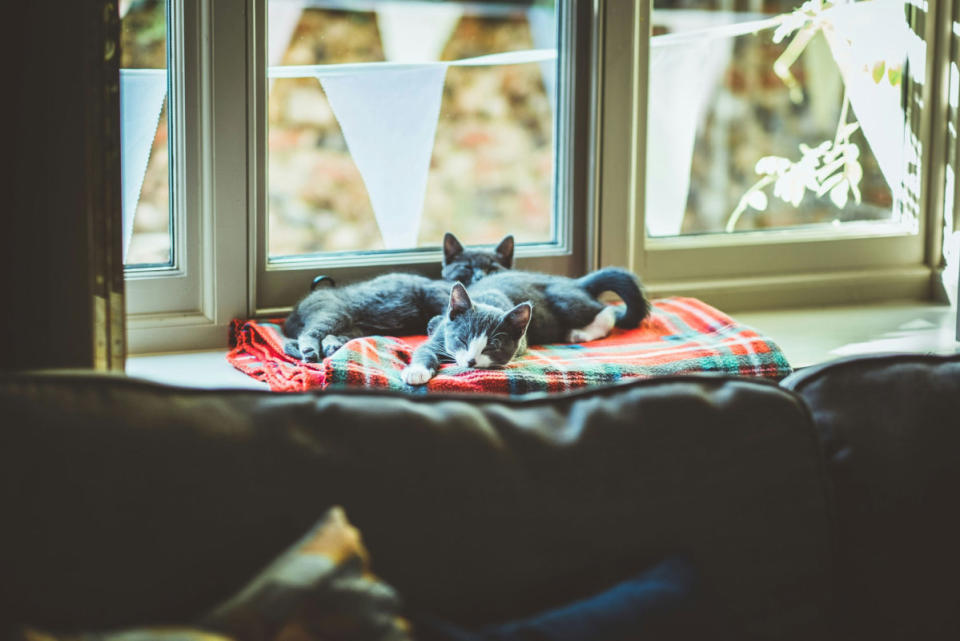How to Clean Your Pet’s Bed
For pet owners, dealing with pet dander and fur is often an unavoidable aspect of daily life. Despite their love for their furry friends, the constant shedding of dander and fur buildup is a perpetual challenge. These microscopic particles settle on furniture, clothing, and carpets, creating a continuous cleaning battle. Managing fur and pet dander starts by keeping your pet's bed clean. Whether you’re hand-washing a dog bed or putting it in the washing machine, a regular deep cleaning can go a long way.
To make sure our cleaning efforts checked all the boxes for a safe and allergy-free home, we connected with Wendy Saladyga, Stain Expert and Senior Manager of Technical Performance at Henkel for all® free clear. While these instructions will help you clean your pet's bed, they also applies to washable upholstery like slipcovers, curtains, pillowcases, bedding, and throw blankets.
1. Vacuum First
Vacuum the fibers. "Many of us know how overwhelming pet hair can get so try vacuuming a pet’s bed before moving forward to the wash cycle," says Saladyga. A vacuum cleaner with a HEPA filter will help reduce the spread of allergens in the air while also capturing loose dirt that settles into the fibers.
2. Use a Pet Stain Remover
Use an enzymatic cleaner to treat pet bed stains. Spot cleaning is an important part of the cleaning cycle. Whether it's pet urine, blood, vomit, or poop, a powerful enzymatic cleaner can help eliminate protein-based deep stains before you put the bedding in the wash.
3. Choose a Safe Laundry Detergent
Quality detergent goes a long way. "Prioritize a free and clear detergent like all® free clear, which is 100% free of dyes and perfumes, removes 99% of allergens*, and is hypoallergenic," suggests Saladyga. Remember, pets can experience allergic reactions and have irritated skin, too. The right pet-safe detergent not only takes care of smells and stubborn stains in the pet bedding, but it's also free of harsh chemicals and is an unscented detergent that delivers a powerful and effective clean.
*Dog and cat dander, dust mite matter, ragweed pollen, grass/tree pollen. all® free clear is not intended to treat or prevent allergies.
Related: 5 Causes of Indoor Winter Allergies + How to Improve Your IAQ
4. Separate Removable Covers
If possible, take the protective cover off your pet bed. Washing it separately from the inner cushion or waterproof liner helps with a more thorough cleaning. If you can't separate the outer cover from the inner stuffing, that's okay, just follow the machine washing instructions from the manufacturer.
5. Use the Presoak and Extra Rinse Cycles
Use a hot water presoak. "Ensure the deepest clean by washing pet beds and covers (or toys) on the highest temperature setting indicated on the label." Presoaking the fibers in hot, soapy water offers similar benefits as laundry stripping. Also set an extra rinse cycle to ensure that the machine machine cleans the fibers of all that dirty water.
"If the bed is not machine washable, check the label to see if you can handwash it using a basin or tub," suggests Saladyga. "Fill your basin or tub with clean hot water (as warm as care label instructions allow). Add detergent and stir it into the water. Then, soak the bed in the water with detergent for an extended period of time (1-3 hours, agitating the fibers every 30 minutes during the cleaning process). Replace with fresh, clean water, and rinse. Continue the process until completely rinsed, and press firmly to remove excess water."
6. Dry Thoroughly
If the bed cover and insert can be put in the dryer, great. Dry according to the directions. Wool dryer balls can help promote hot air circulation so the bedding doesn't just stick to the wall.
If not, opt for air drying. To ensure the clean bedding and covers maintain their shape, try to reshape the bed or fabric before you let it dry.

Photo by Harry Grout on Unsplash
Why is pet dander and fur so hard to get rid of?
Fur and dander are, of course, not just contained to your pet's bed. This is why pet owners with allergies to Fel D1, Can F1, or Can F2 may experience year-round symptoms caused by animal dander, saliva, and skin flakes.
The particles are small. Pet dander consists of tiny, lightweight flecks of skin shed by cats, dogs, and other animals. Not only do they float in the air for extended periods, but they also settle onto surfaces far from the source and permeate the fibers. That's to say, even if you don't let your dog on the couch, you can be sure that his dander has a presence there anyway.
It has adhesive properties. Pet dander and fur can contain natural oils and proteins that act as adhesives, allowing them to stick to surfaces more effectively. It can also carry a static charge, causing it to cling to surfaces rather than being easily swept or vacuumed away.
Shedding is continuous. Your pet may experience seasonal shedding, but they do release dander and fur year-round. Even if you cleaned meticulously, cleaning dander and fur is an ongoing chore.
Related: How to Clean Your Washing Machine—Without Bleach
How do you get pet dander out of other upholstery?
There's no magic cleaning solution. You'll have to adopt a routine cleaning schedule.
Vacuum regularly. Use an upholstery attachment to deep clean the fibers. 10-15 minutes a week goes a long way!
Use a lint roller on a regular basis to collect surface-level pet dander before it settles in
Steam clean the fibers to loosen and remove dander embedded deep in the fabric
Wash removable slipcovers and pillowcases following the above directions
Allergy-reducing sprays like Allerpet claim to help, but it's no permanent alternative for a regular cleaning schedule.

